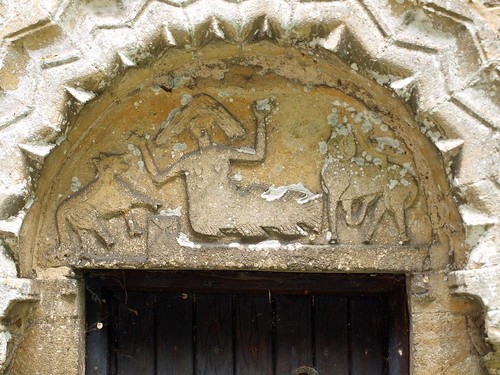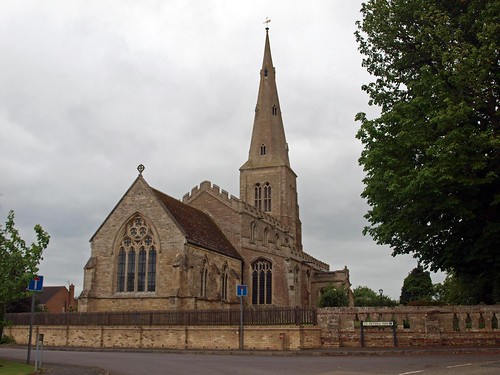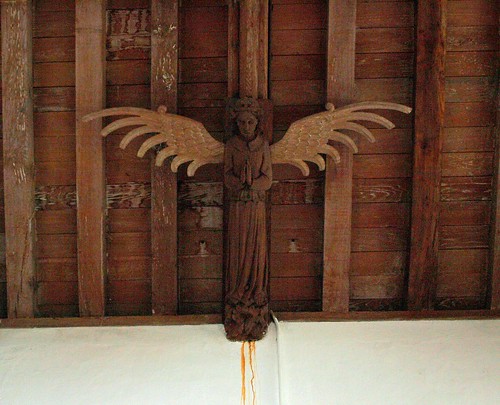St Mary the Virgin, open, is a vast building with a bit of everything - good gargoyles, misericords, bench ends and poppyheads, a brass and some good monuments - and even on an overcast day was full of light. It is a treat to visit and very rewarding both inside and out.
ST MARY. The W tower is exceptionally interesting, as it is Perp in appearance and yet of 1623, though with the use of the materials from the C13 tower which is recognizable by the stiff-leaf responds of the arch towards the nave. The Stuart modifications of the Perp style come out in the W doorway and the windows above it. But the pairs of two-light transomed bell-openings and the recessed spire with its three tiers of lucarnes are Huntingdonshire Perp obviously. The tower is ashlar-faced, the rest of the church is of brown cobbles. Perp are the N and S windows, the big two-storeyed S porch with a broad entry flanked by niches and the not so big N porch, and Perp also the original chancel windows. But the chancel is an E.E. piece; this is shown by the buttressing and the exquisite MASS DIAL on one of them, in the form of an incised rose-window with trefoiled arches between the spokes. The vestry lancet could be re-set from that chancel. The arcades are Perp as well, with a complex continuous moulding to the nave and capitals only to the shafts towards the arch openings. But the E bay of the arcades stands in place of a crossing tower. The two small lancets above the present chancel arch prove that. They were in the tower E wall. The tower no doubt soon turned out to be unsafe and so was replaced by the W tower. - REREDOS and ROOD SCREEN are by Bodley, 1901. - STALLS with a good set of MISERICORDS, said to come from Ramsey Abbey. They show e.g. a WS referring to William Stevens, vicar in 1470-81, a fox and goose, a wyvern, a falcon, a cat, a dog, a rabbit, a monkey, a lion, a horse. - STAINED GLASS. One S aisle window by Morris & Co., c.1896; nothing special. - Much by Kempe (S aisle S 1889; S aisle W 1894; N aisle NE 1896; chancel S 1901; S aisle SW 1903; N aisle NW c.1911). - PLATE. Silver-gilt Cup and Cover Paten 1559-60; Elizabethan Cup. - MONUMENTS. Brass to a Civilian, early C16, a 14 in. figure. - Tablet, d 1696, in the S aisle, rustic but attractive.



GODMANCHESTER. It has one of the proudest names in England, and is worthy of it. It is linked with Cromwell’s town by one of England’s noblest bridges, and it has a link with Alfred and Caesar, for it is said that its name, partly Roman, comes also from a Danish chief with whom Alfred made a treaty of everlasting peace.
We feel as we walk about this serene little town that Time has brought little change to its old-world loveliness. The bridges and the weathered buildings charm the traveller. White houses with ancient timbers and elegant gables look down as they have looked for centuries. There are far too many to pick them out; we walk among them with continual surprise at the scene of beauty that passes before us.
Half town, half country, it is a part of England’s green and pleasant land that would have delighted William Blake as it has delighted our kings on passing through. The people would surge round the royal processions, bringing up their horses and ploughs as the symbol of their energy and prosperity; it is recorded that when James the First passed through on his way from Hinchingbrooke, where his entertainment had been such as he had never seen, they gave him ten teams of horses and two fair ploughs. It is said in an ancient document that Godmanchester was set by as fruitful and flowery meadows as this kingdom yieldeth, and the most spacious of any one parish in fertile tillage. No place in England, said Sir Robert Cotton, had so many stout hinds or employed more ploughs.
The traveller standing on what is called the Chinese Bridge, looking like a scene from a willow pattern plate, will think it a little rural paradise that lies about him. The waters of the Ouse divide themselves and the little wooden bridge leads us over them, from Godmanchester’s small town hall and its Elizabethan school, to the great meadow the town shares with its neighbour. It is known as Port Holme, and it has been called the biggest meadow in Europe, or the widest stretch of grass in any town without a tree. It is a wonderful 300 acres, and looking across it with the backs of the houses on the waterside we may think ourselves in Holland.
We have been into the town hall, in the delightful chamber where the mayor and corporation sit, and have seen in its strong room a great collection of ancient documents. One of them is kept in a tiny leather box, and it was thrilling to open it and find it nothing less than the charter granted by King John two years before the sealing of Magna Carta. On the walls are the long lists of names of mayors for centuries. In a case is the silver mace made in 1745, and in another is the mayor’s gold chain of office. He has the right to proclaim a new sovereign, riding through the streets on horseback, taking the corporation with him; and so ancient are the rights of the people of this town that in certain cases if a man would sell his house or land he must take his wife with him, and she must pass a glove to the mayor as witness that she gives up her own rights in them.
What is called the Causeway is the raised road (shaded by a fine avenue of limes at one end) linking Godmanchester with the medieval bridge at Huntingdon, a stone recording that the Causeway was rebuilt in 1637 by Robert Cooke, who narrowly escaped drowning while crossing the low meadows when the river was overflowing; here still are the two bridges he built to allow the flood waters to run through. Off the Causeway, by the town hall and the Chinese Bridge, is Queen Elizabeth’s Grammar School, much changed but with many stones that have been here since her day, and still a delightful little place. Godmanchester’s most famous son would pass it every day when the walls were new and he was young; he was Stephen Marshall, who used to go gleaning in these fields before he was Chaplain to Parliament in the Civil War.
Schools, bridges, houses, inns, pretty gardens, flowing waters, and pleasant landscapes, we may yet think the great clerestoried church is best of all. It is a spacious spectacle as we come to it, with its soaring spire rising from a 17th century tower which is said to have been refashioned with stones from Ramsey Abbey, Huntingdon Priory, and Hinchingbrooke Nunnery. The chancel is 13th century, the lofty porch is 14th, the nave arcades and the clerestory are 15th. On the outside wall of the chancel is a buttress which has carved on it a beautiful and unexpected piece of ornament by a craftsman of 700 years ago; it is a wheel-panel over six feet. round, with eight trefoiled compartments like leaves radiating from the centre. It is not clear for what purpose it can have been intended, as it could not have been useful as a sundial.
The door in the south porch has a massive lock made by a blacksmith who may have seen the monks turned out of the abbey when Thomas Cromwell and his master seized the monasteries, and above the outer doorway is a sundial carved with fleur-de-lys.
The interior has a fine simplicity, free from fussy memorials, and ancient stone heads of men and angels keep watch on nave and chancel. The font has worn into odd shapes with the centuries, and the 16th century brass portrait of a civilian has lost two wives and two groups of children. There are two 17th century chairs, an altar table of the same age, two Elizabethan chalices, and a chained oak poor box which was damaged last century by a thief who forced it open and threw it into a pond.
But it is for its woodwork that this church is famous. There are modern pews in the nave with 15th century panels of grotesques, birds, fishes, and foliage, and in the chancel we come upon such work as would be the pride of any place. Here are some of the most remarkable choir stalls in England, believed to have been in Ramsey Abbey in its great days. They are 15th century, and have fascinating carving on their heads, their arm-rests, and under the seats. There are 20 of these 15th century stalls, and on the arm-rests are such carvings as a king’s head, a cat with dragon’s wings, a lion’s head with a flowing mane, a jester with a cap and bells, a winged angel on clouds, a crouching beast, and flowers. The carvings under the seats have among them a fox running off with a goose, a fawn rubbing its nose with its foot, a bird on a tree, a hare basking in the sun, a monkey, a demon’s head with horns and his tongue out, an eagle with a scroll, a crouching cat, and an odd little dog asleep on a cushion. There is a masterly carving of a cat with a mouse, and one of the rarest carvings is of a horse lying down.
On the west wall are two stones to a Darby and Joan of Godmanchester known as John and Mary; they lived to be 82 and 93 and their house was by the church. We read that they lived together for 58 years and never at any one time, even for the short time of 40 days, were separately absent from their happy home. It is remembered that when one of their sons followed them, his wife having already been laid in their vault, his brother was preparing the vault for the coffin when the coffin of the wife was accidentally disturbed and her face was revealed, perfect as in life. The uncle of the children in the house across the way hurried across to them and cried “Come and look at your mother”; but they were too late, the form had crumbled into dust. '
In the churchyard is a stone which most travellers pause to read, with one of those grim stories of the countryside so often recorded about a hundred years ago. It tells us that Mary Ann Weems became acquainted with Thomas Weems, and that their acquaintance led to a compulsory marriage, which, being unhappy, led in time to his desertion of her and his marriage to another woman. In time, we read, the wretched man piled up the measure of his iniquity by resolving to murder his first wife, and, pretending to be reconciled, he invited her to travel with him to London, killing her on the road in 1819. In two months he was executed, and the moral of the story ends the long inscription with these lines:
Ere crime you perpetrate survey this stone
Learn hence the God of Justice sleeps not on His throne.
The Gleaner in the Fields
A POOR gleaner in the fields at Godmanchester, Stephen Marshall once filled a grave in Westminster Abbey, his bones being dug up and thrown out with Cromwell’s. The witty malice of old Thomas Fuller represents Marshall as a Presbyterian prototype of the Vicar of Bray: “He was so supple a soul that he brake not a joynt, yea, sprain not a sinew, in all the alterations of times.”
As Marshall was successively Dissenter, Churchman, Presbyterian, Independent, and Presbyterian again, and was thanked by the Commonwealth Parliament for a pamphlet written against the Baptists, there may seem some justification for the gibe, but Marshall was an honest man, seeking to direct the torrent of creeds in which he was caught up, with evangelical religion as his aim, to be groped for in one path after another.
He was a menial in the fields here before he managed to make his way to Cambridge. For a short time a Nonconformist lecturer, he entered the Church as vicar of Finchingfield, Essex, a living worth £1000 a year in our money. He was, however, a Puritan in heart and practice.
His gifts of exposition attracted the attention of Parliament, and, while always retaining his vicarage, he became immersed in the Civil War, and by his eloquence exercised great influence. He is a towering figure in the controversies between Anglicans, Presbyterians, and Independents, and while Fuller was preaching and publishing to the Cavalier forces Marshall was kindling the zeal of the Cromwellians, preaching from regiment to regiment, from one battlefield to another. With his duties in camp and council he combined the part of favourite preacher at St Margaret’s, at six o’clock each morning, and at Westminster Abbey. Marshall was with Laud after his conviction, and with Charles at Holmby House and in the Isle of Wight after his arrest. He preached a magnificent sermon in the abbey at the funeral of Pym, and, dying in 1655, was himself laid with splendour in Henry the Seventh’s Chapel. Six years later his remains were dug up and flung into a pit in St Margaret’s churchyard.
Great preacher though he was, Marshall loved to read a play, and in this connection it is interesting that his wife was a granddaughter of Edmund Alleyn, the actor and friend of Shakespeare.
















